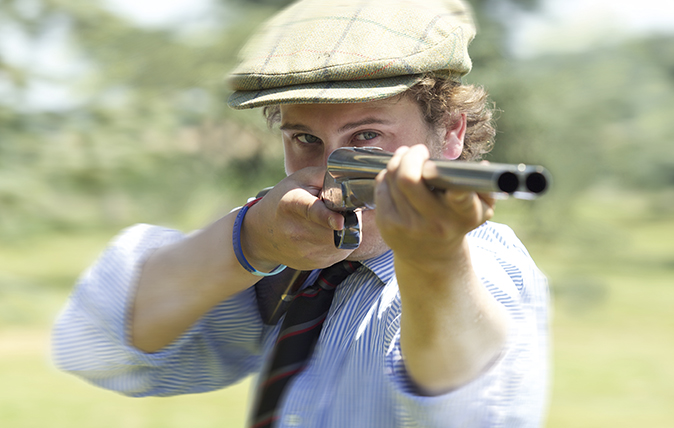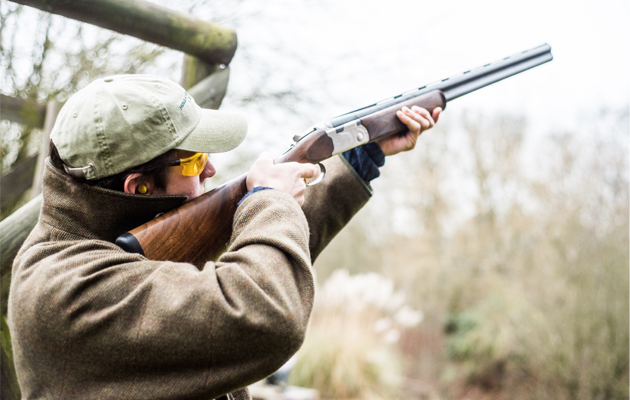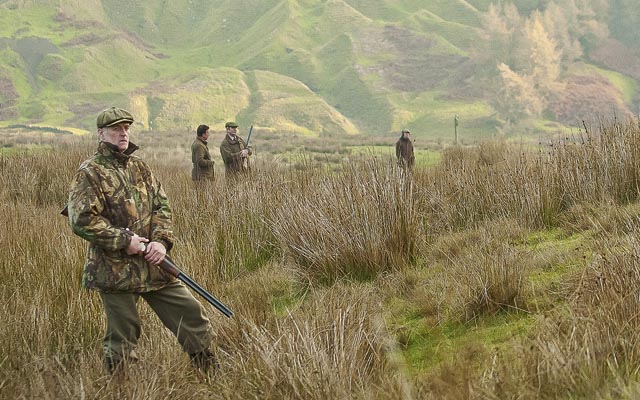How to be a better shot
Many people in the shooting field this season will close one eye as they take aim. This is madness, says a man on a crusade to change the habit of thousands. Rupert Uloth joins the revolution.


There’s an army of Cyclopses out there in the shooting field and, according to one man, they’re thrashing around in a sea of mediocrity, when they could so easily be reaching for the stars. Nick Penn thinks generations of shooting folk have been misled: that they will never be consistent at shooting if they close one eye and that it’s extraordinary that anyone is taught to do so.
‘If you close an eye, you shut down the computer in your brain and lose your triangular vision,’ he explains. ‘You can’t compute how far away the bird is and how fast it’s going. With an eye closed, you’re only guessing at the gap in front of the bird.’
It’s a controversial, not to say incendiary, claim. And, if true, why do people close an eye in the first place? Most top shooting schools will encourage people to close an eye if they are left-eye dominant when they shoot off the right shoulder (unlike being left-handed, being left-eye dominant is fairly common). some shots even wear an eye patch if they have difficulty in closing an eye.
Others go to the extreme of learning to shoot off the opposite shoulder, something that would require having the stock on grandfather’s gun recast or even buying a new one—all quite unnecessary, according to the man who’s changed thousands of people’s lives with a few simple lessons.
‘I couldn’t hit a barn door,’ confesses sir David Tang, a concert pianist who made a fortune in fashion and now adores the sport. He spent the first seven years of his shooting career struggling to shoot well, but now, such is his confidence, he only goes to high-bird pheasant shoots such as Castle hill in Devon and Alnwick in Northumberland.
Wilbur Smith, who is as well-known as a shot as he is a best-selling novelist, came to Mr Penn in despair, but the scales fell from the eye he had been closing. He even thought the first lesson was a fluke and came back the next day, with the same magical results. His hit ratio has more than doubled.
Gary Pickford, described as the ‘Manolo Blahnik of farriers’, travels round the world shoeing precious racehorses, but shooting remains his ultimate passion. ‘Once I’d gone to shooting high pheasants, it wasn’t feasible to use only one eye. You couldn’t kill them cleanly. Nick has transformed my shooting. I would say it improves you between 25% and 45%,’ he reports.
Exquisite houses, the beauty of Nature, and how to get the most from your life, straight to your inbox.
The list of converts reads like a Who’s Who: top surgeons, captains of industry such as former CBI President sir John Sunderland, athletes including former England rugby captain Lewis Moody, who I met at the Pennsport shooting school, and celebrity chefs such as Michel Roux Jr.
I first met Mr Penn on the Heyshott & Graffham Down shoot in West Sussex last season. He was acting as loader, mentor and general bag carrier to a Canadian guest who had to leave early in his helicopter. I had neither a bag carrier nor a helicopter, but I admitted to using only one eye.
When I started shooting more than 40 years ago, I was asked which was my master eye. However, as it’s my left and I shoot off my right shoulder, I was told to close that eye. It was never fully explained why this was necessary, but, at the time, it sort of made sense, as I was then left with an eye trained down the barrel.
Anyone who’s shot a rifle or been in the army is comfortable with the notion of closing one eye to aim down a range or through a telescopic sight. Mr Penn’s point is that shooting with a shotgun is a completely different activity, requiring assessment of speed and direction, and that no single bird ever takes exactly the same trajectory as the one before.
As a one-eyed shot, I’ve had some truly awful days, when I’ve sworn to give the whole thing up. But I’ve also had red-letter days, when my guessing has been particularly good because, with one eye, especially with birds coming straight overhead, I lose sight of them early on and have to guess the rest. You can get quite good at that, but it doesn’t always work and usually goes to pot with high birds.
When I visited Mr Penn at his shooting school near Newbury, Berkshire, he came out with phrases that seemed anathema—‘there’s no such thing as lead’, ‘just shoot at it’ and ‘don’t take it too early’—yet no one has ever made it sound simpler.
‘Your brain is a highly developed computer,’ he explains. ‘It needs both eyes to triangulate a moving object in two dimensions so that it can receive accurate messages. You’ll just know when to pull the trigger.’
‘He doesn’t bombard you with techniques,’ affirms Sir David, ‘but his theory is that we go around looking at the world with two eyes and have a brain that registers everything we see, so why change how we see every day?’
By the end of my session, I was shooting nearly everything and it all seemed very simple, even when Mr Penn was sending over clays from many different directions and at varied speeds. There was indeed ‘a little Irishman’ in my head, telling me when to pull the trigger. It was an extraordinary sensation.
Since my lesson, I have to confess that progress has been patchy because my muscle memory keeps trying to return me to my bad old habits, but I’m certainly making the conversion. When I miss, I know straight away that it didn’t feel right when I pulled the trigger. Allowing instinct to take over is becoming easier and I have to make allowance for the fact that my left arm will tend to pull the gun to the left, which is nothing to do with my eyes.
I owe this change, as a matter of respect, to the quarry and to feel that I can take on the higher birds. In the past, I was told that, if you missed, it was usually because you were behind. ‘When you move on from one eye to two eyes,' says Mr Penn, 'the tendency is to miss in front.' Another myth shredded.
To book a lesson at Pennsport Shooting School, telephone 01635 247635 or 07836 762579. Lessons cost £110–£165, but Mr Penn promises COUNTRY LIFE readers: ‘If I don’t change you, I won’t charge you’
Which is your master eye?
Hold your hand out in front, forming a circle with your forefinger and thumb. Circle an object in the near distance and then close each eye in turn. Whichever eye is open when the object is still in the circle is your master eye.
Nick Penn’s top five tips
1. Look at the bird, not the gun 2. Keep both eyes open 3. Ensure your stance and gun mount are correct 4. Right-shouldered shots should aim at the right edge of the target 5. For right-shouldered shots, the left arm should be doing 85% of the work

Beginner's guide to clay pigeon shooting
We outline our tips for new shots hoping to become top gun.

The joy of rough shooting
In pursuit of a truly mixed bag, Adrian Dangar goes rough shooting in Co Durham.
